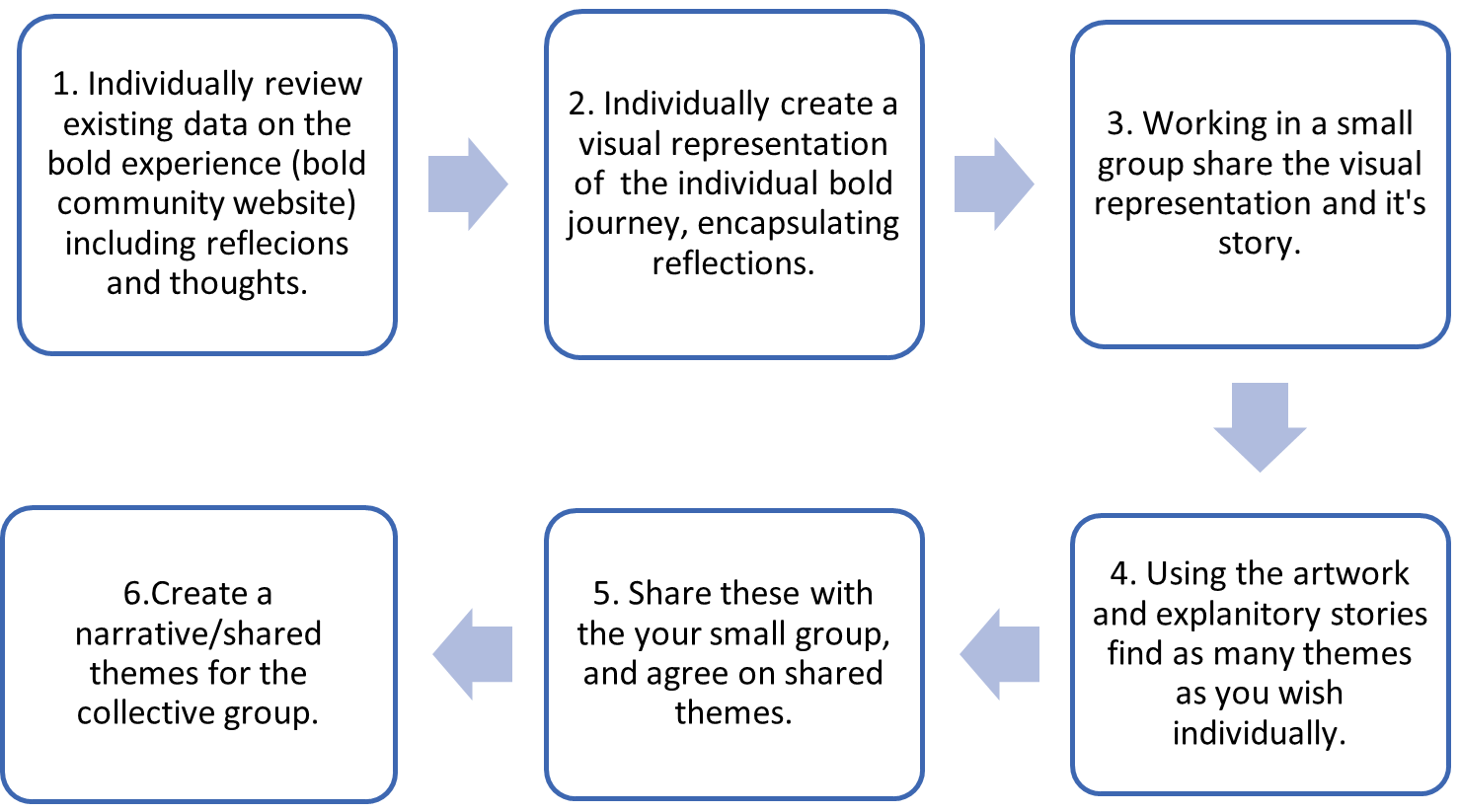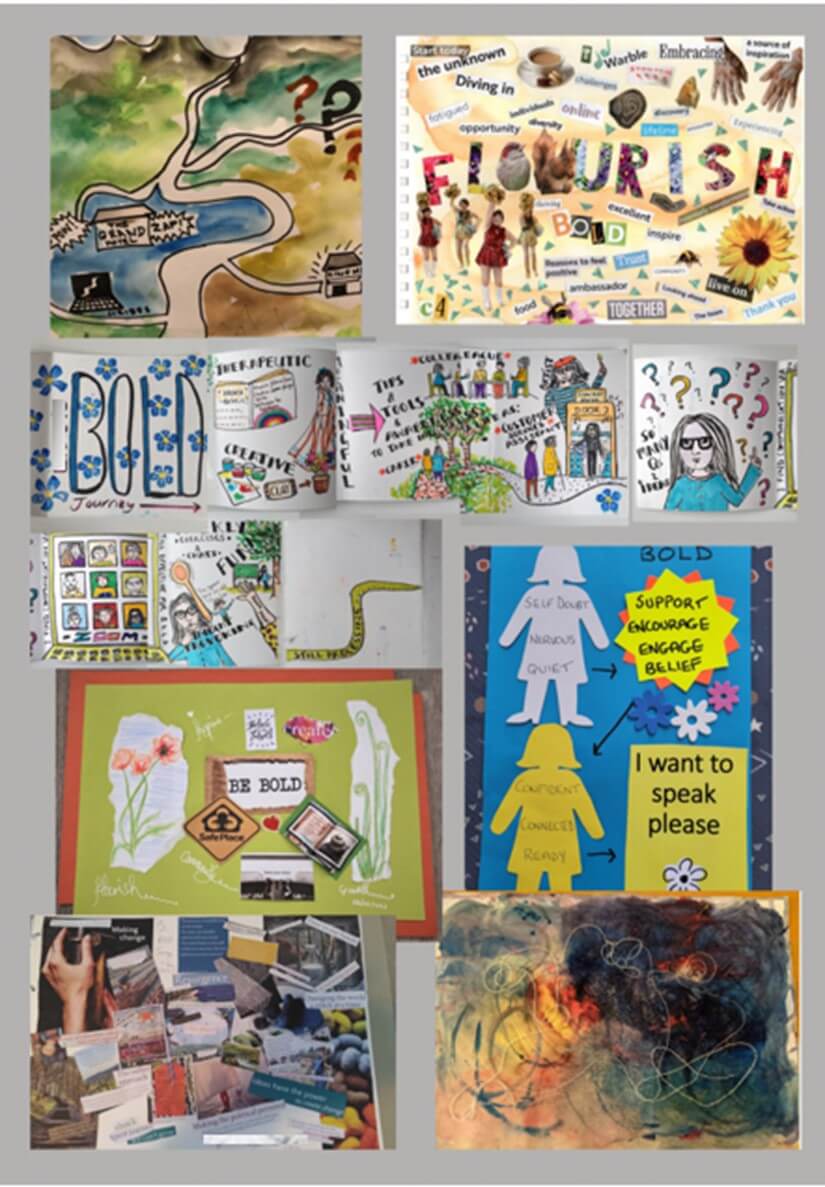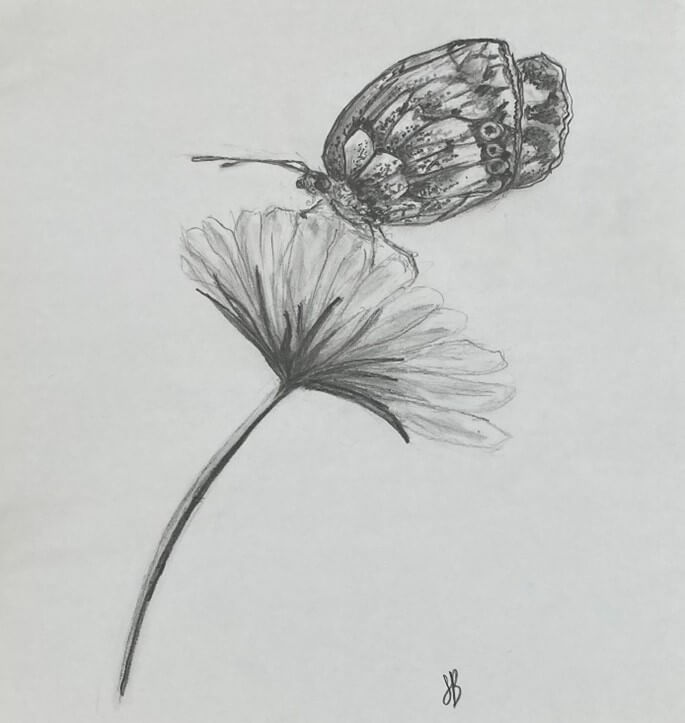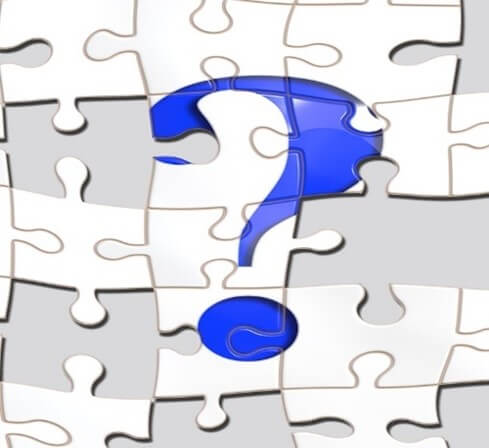bold Masters of Research blog 3 by Suzie Beresford
Boldly discovering
This blog is part of a series of three, it is designed to share the research findings undertaken as part of a Master of Research degree (MRes). It will help the readers to explore the effectiveness of arts-based methods to develop social leaders in Dementia.
In the last blog we explored my life experiences and bold journey, through reflective diary excerpts and reflecting on these (reflexivity). In this final blog we will look at how the rest of the data used in this study was gathered and analysed and how it all links together.

Before we explore the results of the study, I’ll explain the process used to analyse it. The process that was used was ‘creative hermeneutic analysis’ the name does give a clue as it’s about using creative expression to interpret experiences. This analysis process originated with our very own Brendan McCormack. He and Christine Boomer used this method to help further inform a three-year practise development programme for Clinical Nurse leads. This method can help us to learn and express ourselves through creative methods. It helps us to gain knowledge and understanding about ourselves and our reactions as well as how these relate to what we learn from others enabling a different way of knowing. It enables researchers to research ‘with’ people rather than ‘on’ them.
To understand how this was used, we will see how the data was gathered and analysed. Below is the process I used and adapted to suit the online format that was used.

Collecting bold experiences
I put out a call to all bold partners, through the bold facilitators, to ask for their help to discover what themes ran through our bold journeys and analyse them. An online group was then created, and we met on Zoom to discuss our artwork and themes.
Seven bold members including myself gathered online through Zoom to share our visual representations and bold journey’s, I felt great excitement as to what we would discover. This group consisted of people with different experiences of dementia, from being in a carer role currently, close family members living with dementia, working within the dementia field, to living with dementia themselves. This helped to widen my perspective of how the bold programme had impacted those with a different life experience from myself. Before meeting the bold partners, I had completed a collage to help represent my bold journey.

This helped me to reflect on the themes this visual representation had helped to express. I went on to identify four main themes from my artwork and further reflections.
- Bold felt like a safe place
- Sense of community
- Inspired by others and the programme
- Confidence to be ‘bolder’
I reflected on why I felt at ease when taking part in bold, discovering that for me bold had been a safe place. Which enabled me to be able to express myself more fully and in turn gain confidence, I went on to share this later with the online group.
“…it gave me a safe- place to share my story to create and grow as a person. I felt a sense of community and felt inspired by those around me…I also feel it has enabled me to discover myself and build-up self-worth, in fact it’s given me confidence to be ‘bolder’. ” (Reflective diary excerpt 04/08/2023 8am).
Each bold partner had also created an artwork to represent their individual journey.

When we met online we introduced ourselves as we were from different bold cohorts. The bold partners then split into three groups to discuss the artwork created and discover the themes of each group. Each group discovered the agreed themes that ran through their bold journeys. The table below helps to show what each group discovered.

We came back together to discuss what we had discovered. It was from this session we were able to identify a number of similar themes coming through from all of the small groups. There were three main themes that ran throughout:
- Community
- Connection
- Transforming
Let’s discuss each collective theme to see the connections to my experience and the experiences shared by the bold partners who took part.
Community
I was able to see that the safe place and sense of community I had felt within bold had also been felt by other bold partners; through the resulting wider community that had been formed. Abraham Maslow helps us to see that a safe and supportive space can enable further human needs to be met, such as belonging and raised self-esteem in his paper ‘A dynamic theory of human motivation’. Maslow describes the needs that all humans have within this through his theory of human motivation, which identifies human needs. It explores these needs and helps to show how meeting these can enable us to realise our potentials and flourish. Within this theory he explains that once our physical needs are met we need to feel safe to enable us to go on to feel belonging, love, create self-esteem and enable self-actualisation. In my experience the need for safety could be said to be met by the bold community as it created a safe and supportive place to enable, connection or belonging and this in turn enabled a process of transformation or as Maslow puts it self-actualisation.

Maslow published many papers as well as books throughout his life; in his book ‘Towards a psychology of being’ there is a chapter entitled ‘The need to know and the fear of knowing’, it helps to relate the role that fear can play in inhibiting transformation. As previously mentioned in blog 2 my background had contributed to part of the fear I have felt about sharing my story and prohibited personal grown. By fulfilling the need for safety through having a safe place, a sense of community within bold and further reflection I have been able to flourish and grow.
The online session enabled me to learn the various ways this sense of community had been felt, through support, empathy and the ability to ask each other’s views and sharing experiences. One partner said the community had enabled them to “ be real with themselves” and the bold community, expressing their feeling beyond just thinking in a way that is expected. Bold enabled an expression outside the limits of words and challenged previously held beliefs.

Another had felt being able to ask those with lived experience of dementia helped inform the ways in which their carer role was fulfilled. It had helped to identify some of the sensory issues which may affect the responses of the loved one they cared for, as they were unable to verbally communicate with them. They related that having a mix of different experiences was useful in providing insights and understanding. While another partner felt a little uncomfortable as they were the only person living with dementia within their cohort, this brings out the importance of finding ways to encourage more of those living with dementia to have a role in such programmes.
By the end of the bold programme those taking part began to feel like a team, through both the partners they had met and facilitators as they had been a great support, and this enabled belonging. Just seeing other artwork had moved and inspired bold partners as there were so many and interpretations for the brief set each week. The resulting communities formed provided an overview of different experiences of dementia and how all of those affected by dementia had relevant voices, while providing a safe place to share stories, be heard and feel supported.
Connection
There was an overlap in themes as through the community that had been created connections were formed. These could again be seen in support, sharing stories finding common ground and being inclusive. Bold had also enabled the forming of networks to produce a wider community out with original partners which enabled further projects to be set up. As a result, other dementia communities benefitted through bold mini commissions (these are small bold funded community projects which are ran by bold partners).
Bold partners described what they had learned from bold as going “beyond bold”. For instance, taking part in bold sparks, bold scribes and mini commissions, so for them it had been continuous and wasn’t just a course it had led to a much wider impact “a ripple effect”. Some of the connections that had been formed had been intergenerational allowing children to connect with those in care homes through music and song. It was likened to an analogy of thread or yarn, all going in different directions yet being connected and having the ability to “change (changing) the world one stitch at a time” linking into the transformative effect of bold. This sense of connection could also be seen in connecting with yourself and enabling individuals to reconnect with their thoughts and emotions.
While bold partners had been able to further their connections through bold, one partner mentioned time constraints due to their carer role. This had meant they couldn’t always manage to plug back into the further community connections. They felt relieved on one hand when the bold programme ended as it gave them more time to fulfil carer responsibilities but, they felt a sense of loss as it had come to an end, it had helped them feel fulfilled, like they belonged. The programme had made them feel part of something, supported and listened to preventing them from feeling ‘alone’. This shows the importance of taking time to take care of yourself out with a carer role but also highlights the difficulty of finding the time to do so. As I explained previously when discussing my grandparents this thought relates to my grandpa’s carer role and the resulting negatives effects of not taking time to look after his own needs.
Transforming
There had been noted transformation both individually and collectively within the communities that had been formed. Some who didn’t view themselves as creative had been able to tap into creativity and had found it fun, becoming less apprehensive and had used the concepts of bold within their various roles. While partners felt this had given them the drive and confidence to ‘be bold and be brave’, reaching out beyond what they would have done previously.

One partners visual interpretation went beyond just the programme, but they related it also showed how their creative process had changed. They had the belief system that they were “not good at art” and that they “don’t do art” however, after taking part started to feel differently. This had previously been a big block to create for them, but they began to enjoy being able to express themselves through visual art raising their self-esteem and enabling them to flourish.
Another partner explained that they have always enjoyed art but had felt nothing they did was good enough. By taking part in bold gave them permission to embrace the imperfection even when they felt a little uncomfortable with some of the different methods such as singing they learned “ to embrace the silliness” and give it a go. They stopped worrying about the end result or how they looked to others, enjoying the process. The journey had “lifted them” and was a “lifeline” at the time as their carer role was intensive. The six weeks of bold had been “very precious” to them and in a way it was a respite.
Bold had enabled self-belief, building confidence to enable social leadership by informing the various role of partners while helping to inspire those who took part. I had been a recipient of this transformative change as previously discussed I had felt a newfound confidence, enabling self-discovery and this had enabling me to undertake this project. Bold had helped partners to flourish and change preconceptions and helped to become “food for the soul” by providing ways to cope with some of the challenges when in a carer role.
The transformation was twofold as not only did it change perceptions of art-based methods, but it also changed perceptions of personal abilities while understanding one’s self more which enabled both growth and flourishing. It enabled the learning through the bold journey to move forward, creating “ripples” beyond bold.
Answering my guiding question

“How do arts-based methods facilitate equality of voice, democratise, and encourage engagement in group settings?”
I was able to discover that arts-based methods used within bold provided a means which enabled both equality of voice and social leaders to be created within a group setting. The programme had encouraged empathetic approaches to provide an informed understanding, whatever the lived experience of dementia was all voices were seen as important. This led to communities developing, connections being formed and transformation, whether this be individually or part of a wider group. The social leaders that had been created went on to incorporate what had been learned within their roles and to be involved in further “bold ripples”. I could also see that other bold partners had also felt confidence, inspired and benefited from the sense of community after taking part in bold. Some the themes I had identified as having an impact on me had indeed been felt by other bold partners.
The study also addressed some of the identified gaps in interventions in the literature review:
- The need to ensure the voice of those with lived experiences both living with and caring for.
- Having the knowledge needed to facilitate and understand individuals and interventions.
Bold brings these aspects into their programme, by making all voices equal and taken into account while also providing a platform to gain further knowledge and understanding of individuals and creative methods. This created an overlap as the voices of all those affected created a shared understanding and generated knowledge. Unlike the previous studies within the literature review this knowledge wasn’t just used by those facilitating, although the facilitators of bold were supportive, skilled and knowledgeable. Further knowledge was generated during the bold programme by all participants which helped to inform and widen understanding of both themselves and others. While enjoyment wasn’t just felt by watching those living with dementia experience the joy of creating but it was felt by taking part in the programme.
Further learning

Similarities could be seen within the literature reviewed and the results of the bold study, as a number of studies highlight the confidence gained by being part of a supportive community, learning new skills and enabling connection. In fact, one of the studies brought out the importance of including those with a lived experience of dementia (either living with or those within a carer role) as it enabled everyone to take part and enabled participants to enjoy the process while creating a sense of community. Another, shows the confidence gained and the enjoyment felt in the creative process. They alongside others relate that, participants felt inspired by each other and that they were in a failure free environment. Studies also point out carers were able to use creative methods out with the activities and use these skills in their carer role. It was noted that those within a carer role felt respite from their role as carer which was brought out within the earlier literature review.
The importance of sharing stories helped to provide connection and social inclusion within a group settings in fact a number of studies highlighted the need for each other’s involvement through groups to benefit from the process involved within the ‘Arts’ used. The results within this bold study also showed similar findings; art-based methods were facilitated through a group setting and the participants felt inspired by each other, confident in themselves as part of a supportive community. Participants were able to use this community to further their knowledge and gain connection through the shared experiences of others. Some bold partners were able to feel differently about being creative when they were previously apprehensive, enjoying the process and using their creativity out with the programme as a newfound skill.
Those bold partners within a carer role explained how they felt respite from their role as carer which was also brought out within the studies in the literature reviewed. However, one of the key differences between the literature previously reviewed is that; using arts-based activities to enable expression, communication, connection, and a sense of self in people living with dementia was also used and felt by those with different life experiences. Those within various roles, such as carers also felt these effects when participating the arts-based methods used within bold.
There were limitations within the study as the sample size used was small but, this provided rich descriptive data. As the study is in agreement with the literature reviewed it also identified the benefits outlined; connections being formed, inclusion, enjoyment, belonging, reduced carer stress and a change in perceptions both of dementia and art-based methods (see the reference list found in blog 1). This helps not only to add to the body of evidence but to strengthen the research findings.
While this study only covers the bold project and may limit it’s transferability in other types of settings, it does highlighted ways for further application and future investigation. It addressed how arts-based methods can be incorporated to establish; support, a means to further understand each other through needed expression and connection for all affected by dementia. While also using social leadership as model, which has wider implications for embedding in practice and policy for dementia support or care to help provide ways to make all voices important and taken into consideration.
Thanks for taking the time to discover the impact bold has had both on myself and the bold partners who joined me in this research project.

Acknowledgements
I would like to thank all who participated in this project, the bold team, the bold partners who took part, family and friends and my supervisors.
To my supervisory Team, Dr Karen Rennie and Prof Brendan McCormack, for their unwavering patience, support and guidance.
I would also like to thank my partner Pete, friend Laura, cousin Linsay and my brother Michael for their continued support, positivity and understanding; while I went on my autoethnographic journey of discovery and worked through this project over many evenings and weekends limiting my availability. With special thanks to Pete for putting up with a very messy dining table for the best part of a year!
